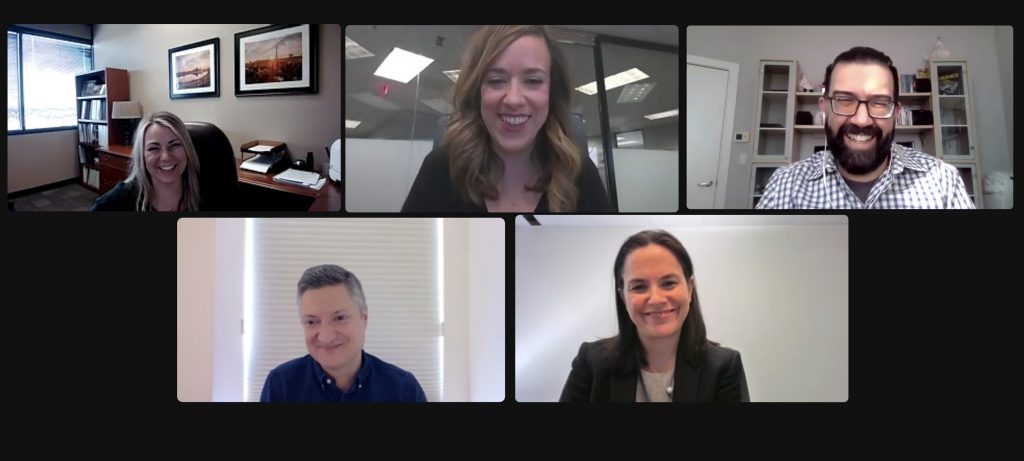The COVID-19 pandemic has accelerated demands on the workforce and companies are addressing it in a variety of ways, said panelists during a Flexible Workforce Webinar on February 10 attended by more than 40 Member Companies. The webinar was sponsored by the I&D Engagement and HR Committees.
Advisory Board Member and HR Committee Chair Bonnie Houston, NOV, moderated the discussion with Maria Lorente, Schlumberger, Jonathan Pearce, Deloitte, and Asi Klein, Deloitte. Pearce kicked off the webinar with a presentation on the challenges and opportunities that come with a hybrid work environment.
COVID-19 caused a quantum leap into the future, Pearce said, perhaps permanently altering ways of working.
“The workplace is being redefined and re-architected with technology, wellbeing is being redefined, flexibility enhanced and the power of the workforce is unleashed from location. COVID has accelerated trends that were already underway, with a real focus on new technologies in the office work spectrum and mass adoption of collaboration tools.”
Jonathan Pearce, Deloitte
He said a Nielsen survey recently found that 80% of employees would prefer to work for a company that gives them the freedom to pick an office location of their choosing, while 50% said they will choose to keep working from home even after the pandemic has ended.
Pearce said there is a pressure on managers and team leads to manage the trade-off of worker preference versus workplace culture.
“People leaders will find this a challenge, but also the greatest key to success,” he said. “Team leads will set team norms and expectations, ways of communicating and the expectations of team members.”
Klein added that the energy sector’s frontline workforce – manufacturing, field services and engineering – can benefit from important conversations about technology and the digital space.
Lorente described what Schlumberger has done to create a flexible work environment. She said a flexible workplace has become the new norm and the only way forward is to evolve.
“We migrated the entire company to a next generation of collaboration platforms. We also developed internal applications and an IT infrastructure, as well as launched pilots in field operations, technology and offices to measure outcomes and quality metrics. So in the end, what we have is a global program that enhances employee experience but also drives business performance.”
Maria Lorente, Schlumberger
Houston asked what role inclusion and diversity plays in setting the strategy for companies, as well as opportunities and risks going forward. Klein noted that leadership is changing.
“What does that mean to lead in today’s society, in these major cultural shifts and shifts around technology and what is happening in the business? Leaders can be more deliberate about redefining the future of work. How, as a leader, do you think about unleashing value for the workforce and position employees to drive strategic work?”
Asi Klein, Deloitte
Lorente pointed out that as leadership styles evolve, remote operations and automation offer opportunities to bring more women into the workforce and retain a wider pool of talent.
“Flexibility will bring in more women, but also those who have accessibility issues,” she said. “If you no longer have to be physically at a wellsite to do a data logging operation, for example, that opens up a wider talent pool, including those who need visas and those with physical disabilities.”
As these programs have rolled out, Houston asked how companies measure success.
Pearce said team leaders need ways of getting more information and engaging their teams in open dialogue about communication preferences and decision-making.
“We’ve seen that teams who have embraced agile work practices are doing better in a hybrid environment. By giving the managers better information, we’re getting the collective learnings from across the organization and then distributing best practices to teams. We’re trying to speed up our learnings and get more effective, faster.”
The Department of Labor Statistics released data on worker productivity in 2020, and it was the first growth in U.S. workforce productivity in a decade, Pearce said.
“We need to get some more thoughtful design around workflows and how teams can be more effective while productivity gains become more sustainable,” he said.
Klein said that companies should start moving away from metrics on productivity to metrics around value creation. Lorente noted that “team” is the key word.
“As a team, we can decide what we do. If you have a team where some are remote and some are in the office physically, you will decide as a team when decision making happens, because you don’t want to have inequity where people in the room will have a discussion and those who are remote will have no input.”
Roni Ashley, Director Operations, writes about the Council’s HR Committee, Membership and regional chapters. Click here to subscribe to the Energy Workforce newsletter, which highlights sector-specific issues, best practices, activities and more.





